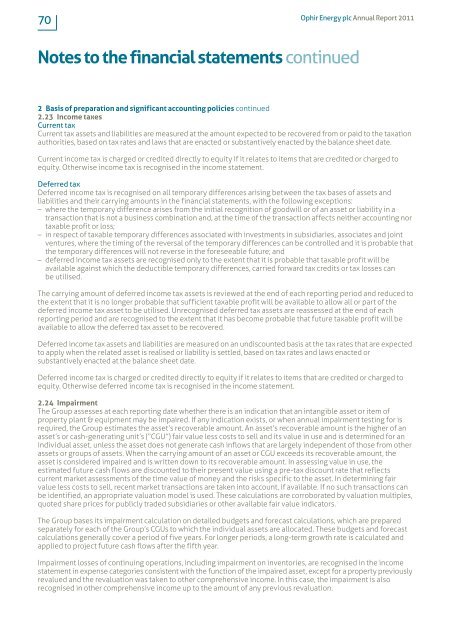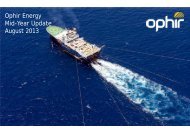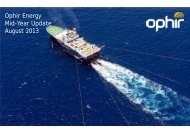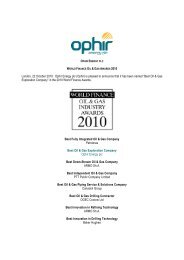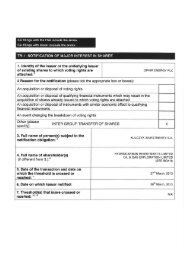Ophir Energy plc Annual Report and Accounts 2011
Ophir Energy plc Annual Report and Accounts 2011
Ophir Energy plc Annual Report and Accounts 2011
Create successful ePaper yourself
Turn your PDF publications into a flip-book with our unique Google optimized e-Paper software.
70<br />
<strong>Ophir</strong> <strong>Energy</strong> <strong>plc</strong> <strong>Annual</strong> <strong>Report</strong> <strong>2011</strong><br />
Notes to the financial statements continued<br />
2 Basis of preparation <strong>and</strong> significant accounting policies continued<br />
2.23 Income taxes<br />
Current tax<br />
Current tax assets <strong>and</strong> liabilities are measured at the amount expected to be recovered from or paid to the taxation<br />
authorities, based on tax rates <strong>and</strong> laws that are enacted or substantively enacted by the balance sheet date.<br />
Current income tax is charged or credited directly to equity if it relates to items that are credited or charged to<br />
equity. Otherwise income tax is recognised in the income statement.<br />
Deferred tax<br />
Deferred income tax is recognised on all temporary differences arising between the tax bases of assets <strong>and</strong><br />
liabilities <strong>and</strong> their carrying amounts in the financial statements, with the following exceptions:<br />
––<br />
where the temporary difference arises from the initial recognition of goodwill or of an asset or liability in a<br />
transaction that is not a business combination <strong>and</strong>, at the time of the transaction affects neither accounting nor<br />
taxable profit or loss;<br />
––<br />
in respect of taxable temporary differences associated with investments in subsidiaries, associates <strong>and</strong> joint<br />
ventures, where the timing of the reversal of the temporary differences can be controlled <strong>and</strong> it is probable that<br />
the temporary differences will not reverse in the foreseeable future; <strong>and</strong><br />
––<br />
deferred income tax assets are recognised only to the extent that it is probable that taxable profit will be<br />
available against which the deductible temporary differences, carried forward tax credits or tax losses can<br />
be utilised.<br />
The carrying amount of deferred income tax assets is reviewed at the end of each reporting period <strong>and</strong> reduced to<br />
the extent that it is no longer probable that sufficient taxable profit will be available to allow all or part of the<br />
deferred income tax asset to be utilised. Unrecognised deferred tax assets are reassessed at the end of each<br />
reporting period <strong>and</strong> are recognised to the extent that it has become probable that future taxable profit will be<br />
available to allow the deferred tax asset to be recovered.<br />
Deferred income tax assets <strong>and</strong> liabilities are measured on an undiscounted basis at the tax rates that are expected<br />
to apply when the related asset is realised or liability is settled, based on tax rates <strong>and</strong> laws enacted or<br />
substantively enacted at the balance sheet date.<br />
Deferred income tax is charged or credited directly to equity if it relates to items that are credited or charged to<br />
equity. Otherwise deferred income tax is recognised in the income statement.<br />
2.24 Impairment<br />
The Group assesses at each reporting date whether there is an indication that an intangible asset or item of<br />
property plant & equipment may be impaired. If any indication exists, or when annual impairment testing for is<br />
required, the Group estimates the asset’s recoverable amount. An asset’s recoverable amount is the higher of an<br />
asset’s or cash-generating unit’s (“CGU”) fair value less costs to sell <strong>and</strong> its value in use <strong>and</strong> is determined for an<br />
individual asset, unless the asset does not generate cash inflows that are largely independent of those from other<br />
assets or groups of assets. When the carrying amount of an asset or CGU exceeds its recoverable amount, the<br />
asset is considered impaired <strong>and</strong> is written down to its recoverable amount. In assessing value in use, the<br />
estimated future cash flows are discounted to their present value using a pre-tax discount rate that reflects<br />
current market assessments of the time value of money <strong>and</strong> the risks specific to the asset. In determining fair<br />
value less costs to sell, recent market transactions are taken into account, if available. If no such transactions can<br />
be identified, an appropriate valuation model is used. These calculations are corroborated by valuation multiples,<br />
quoted share prices for publicly traded subsidiaries or other available fair value indicators.<br />
The Group bases its impairment calculation on detailed budgets <strong>and</strong> forecast calculations, which are prepared<br />
separately for each of the Group’s CGUs to which the individual assets are allocated. These budgets <strong>and</strong> forecast<br />
calculations generally cover a period of five years. For longer periods, a long-term growth rate is calculated <strong>and</strong><br />
applied to project future cash flows after the fifth year.<br />
Impairment losses of continuing operations, including impairment on inventories, are recognised in the income<br />
statement in expense categories consistent with the function of the impaired asset, except for a property previously<br />
revalued <strong>and</strong> the revaluation was taken to other comprehensive income. In this case, the impairment is also<br />
recognised in other comprehensive income up to the amount of any previous revaluation.


